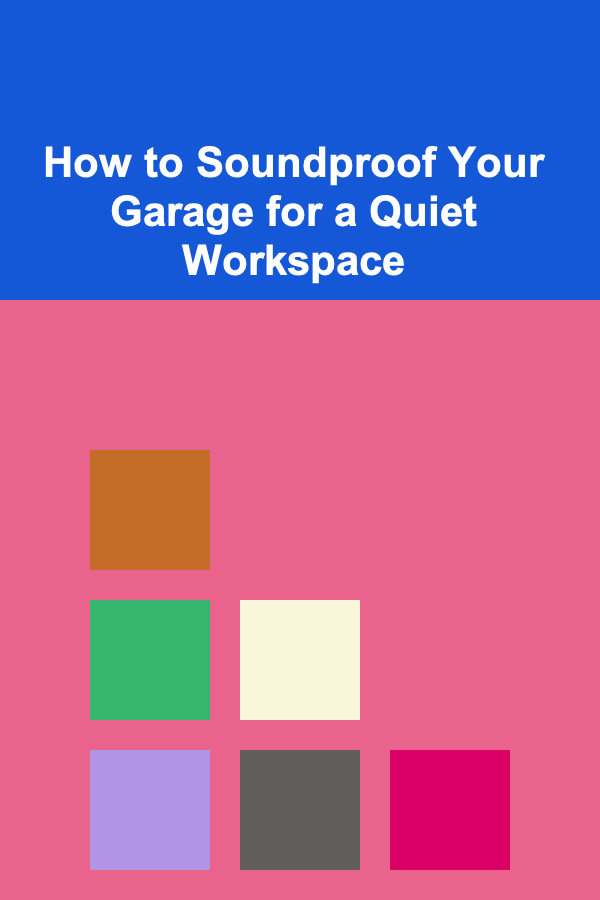
How to Soundproof Your Garage for a Quiet Workspace
ebook include PDF & Audio bundle (Micro Guide)
$12.99$11.99
Limited Time Offer! Order within the next:

The garage is often one of the most overlooked areas when it comes to creating a comfortable and quiet workspace in your home. It's not uncommon for a garage to serve as a multi-functional space---used for everything from a carport to a storage area, and sometimes even a workshop or personal office. However, the acoustics in a garage often leave much to be desired, making it a noisy and distracting environment for those who are looking for a quiet space to focus, create, or work.
Soundproofing your garage can help mitigate external noises such as traffic, neighbors, or the constant hum of machinery and tools, turning the space into a peaceful sanctuary for productivity. Whether you're setting up a home office, a music studio, or simply want to escape from the noise of everyday life, there are effective methods for minimizing sound and ensuring that your garage offers the tranquility you need.
In this article, we will explore the different strategies and techniques for soundproofing your garage to create a quiet and comfortable workspace. From the basics of soundproofing to more advanced measures, we'll cover everything you need to know to transform your noisy garage into a serene environment.
Understanding Soundproofing: The Basics
Before diving into the specifics of how to soundproof your garage, it's essential to understand the fundamentals of soundproofing and how sound behaves. Sound is essentially vibrations that travel through the air or through solid materials. When you hear a noise, it's the vibration of air molecules reaching your eardrums, causing them to move in response.
There are several key principles involved in soundproofing:
- Mass: Heavier materials absorb and block sound more effectively than lighter materials.
- Damping: This refers to the process of converting sound energy into heat, which can help reduce sound transmission.
- Decoupling: By separating two surfaces that would otherwise be connected, you can prevent sound vibrations from traveling between them.
- Absorption: Soft materials that absorb sound waves help reduce noise levels and reverberation within a space.
When it comes to soundproofing your garage, a combination of these strategies will help achieve the best results. The goal is to reduce the amount of sound that enters or leaves the space, as well as to minimize the amount of noise that bounces around within the garage.
Insulating Your Garage Walls
One of the most effective ways to reduce noise in your garage is by insulating the walls. Sound travels through walls, and if your garage walls are thin or poorly insulated, they will easily transmit both external noise (such as traffic or neighbors) and internal noise (such as the sound of tools or machinery).
2.1. Adding Mass to the Walls
Mass is one of the key factors in soundproofing. Adding heavy materials to the walls of your garage will block and absorb more sound. You can accomplish this by:
- Installing drywall: If your garage doesn't already have drywall, installing an extra layer of high-density drywall on the interior of the walls can significantly improve sound insulation. This added mass helps block sound from traveling through the walls.
- Mass-loaded vinyl (MLV): MLV is a flexible, heavy material designed specifically for soundproofing. It can be applied directly to walls and is effective at blocking both airborne noise and impact noise.
- Acoustic panels: Acoustic panels are designed to absorb sound waves, reducing echo and reverberation in a room. By attaching these panels to your garage walls, you can control the acoustics and minimize unwanted noise.
2.2. Adding Insulation Between the Studs
If your garage has exposed studs, you may want to consider adding insulation between them. There are several types of insulation that work well for soundproofing:
- Fiberglass batt insulation: This is one of the most common insulation materials, and it's relatively easy to install between studs. It helps absorb sound and prevents it from passing through the walls.
- Spray foam insulation: Spray foam expands to fill gaps and cracks, providing a better seal than traditional fiberglass batt insulation. It also has the added benefit of providing thermal insulation, which can help regulate temperature in your garage.
- Cellulose insulation: Made from recycled paper products, cellulose is an eco-friendly option that is effective at soundproofing. It is often installed using a blowing machine to fill the wall cavities.
By adding insulation between the studs, you can dramatically improve the soundproofing in your garage. Not only will it block external noise, but it will also help prevent sound from escaping, making it a more peaceful space.
2.3. Sealing Gaps and Cracks
Even the best insulation will be ineffective if there are gaps or cracks in the walls. Sound can travel through these small openings, reducing the effectiveness of your soundproofing efforts. To improve the sound isolation in your garage, make sure to seal any gaps or cracks in the walls, including:
- Around electrical outlets: Electrical outlets can create gaps in the wall where sound can leak through. Use acoustic sealant or foam gaskets to seal these areas.
- Around windows and doors: Windows and doors are often the weakest points in a wall's soundproofing. Ensure that the window frames are properly sealed, and consider replacing old windows with double-glazed ones that offer better noise reduction. Similarly, ensure that door frames are airtight and install weatherstripping to reduce sound leakage.
Sealing gaps is a simple but effective step in improving the soundproofing of your garage.
Soundproofing the Garage Door
Garage doors are often made of thin metal or wood, which can be a significant source of noise leakage. Sound can easily travel through a garage door, so it's important to address this area as part of your soundproofing efforts.
3.1. Adding Mass to the Garage Door
Similar to the walls, adding mass to the garage door can help block sound. You can achieve this by:
- Installing soundproofing panels: There are soundproofing panels available that are designed specifically for garage doors. These panels are made from dense, heavy materials and can be attached directly to the door to reduce noise.
- Using mass-loaded vinyl (MLV): Mass-loaded vinyl can also be applied to garage doors. It's a flexible and effective material for blocking sound, and it's relatively easy to install on your garage door.
3.2. Insulating the Garage Door
Adding insulation to the garage door will help reduce both sound transmission and temperature fluctuations. Many garage doors have little to no insulation, so this is a simple but highly effective upgrade. You can use foam board insulation, fiberglass batt insulation, or reflective foil insulation to line the inside of the garage door.
In addition to soundproofing, this insulation will also improve the energy efficiency of your garage, keeping the temperature more stable and reducing the need for heating and cooling.
3.3. Installing a Door Seal
A garage door seal is essential for preventing sound from escaping or entering through the gaps between the door and the floor or sides. There are various types of door seals available, including rubber and vinyl options. Install a high-quality seal around the edges of the garage door to ensure a tight fit.
Soundproofing the Floor
The floor of your garage can also transmit sound, especially if it's made of concrete or another hard surface. If you're looking to create a truly quiet workspace, you'll need to address the floor as well.
4.1. Installing Carpet or Rugs
While hard floors can amplify sound, soft surfaces help absorb sound waves and reduce noise. Consider installing carpet or large area rugs on the floor of your garage to help absorb sound. Thick rugs or mats can be especially helpful in reducing impact noise from footsteps or dropped tools.
If you don't want to cover the entire floor, you can strategically place rugs in high-traffic areas or near noise-generating equipment.
4.2. Adding Acoustic Flooring
For a more advanced soundproofing solution, you can install acoustic flooring systems. These systems typically consist of a combination of dense layers of material, such as rubber, cork, or foam, designed to absorb sound and prevent noise from traveling through the floor.
Installing Soundproof Windows
If your garage has windows, they are another area where noise can leak in. Upgrading your windows is a key step in soundproofing your garage.
5.1. Double-Glazed Windows
Double-glazed windows feature two panes of glass with a layer of air or gas between them. This extra layer helps block sound, making double-glazed windows much more effective at noise reduction than single-pane windows.
If replacing the windows is not an option, you can apply a secondary acrylic window inside your existing windows. This can create an air gap between the two surfaces, providing similar benefits to double glazing.
5.2. Window Inserts
Window inserts are another cost-effective way to improve soundproofing. These inserts are placed over the existing windows to provide an additional layer of sound insulation. They are removable, which makes them a flexible option for renters or those who don't want to permanently replace their windows.
Create a Quiet Environment with Furniture and Decorations
Once you've addressed the primary sources of noise in your garage, it's time to focus on the acoustics of the room itself. Adding furniture and decorations can help absorb sound and reduce reverberation, further enhancing the quiet atmosphere in your workspace.
6.1. Add Soft Furnishings
Furniture such as upholstered chairs, sofas, or cushions can help absorb sound in the room. The more fabric and soft materials you have in the space, the better the sound absorption.
6.2. Use Sound Absorbing Decorations
In addition to furniture, you can incorporate other sound-absorbing materials into your garage. Wall hangings, tapestries, curtains, and even bookshelves filled with books can all help absorb sound and reduce echo.
Conclusion
Soundproofing your garage is an essential step in creating a quiet and productive workspace. By addressing the various sources of noise---from walls and doors to windows and floors---you can transform your garage into a serene environment free from distractions. Whether you're working on a hobby, running a business, or simply need a quiet place to escape, the right soundproofing techniques will ensure your garage is the perfect setting for focus and creativity.
With a combination of insulation, mass, sealing, and sound-absorbing materials, you can successfully soundproof your garage and enjoy the benefits of a peaceful workspace.

How to Create a Baby Travel Essentials Kit for On-the-Go Parents
Read More
How to Make Your Home Smell Like the Holidays with DIY Scents
Read More
How to Manage Shared Apartments to Foster a Positive Living Environment
Read More
How to Save Energy with Smart Lighting Solutions
Read More
How To Support Employee Wellbeing in a Remote Setup
Read More
How to Use Pendant Lights to Elevate Your Kitchen Design
Read MoreOther Products

How to Create a Baby Travel Essentials Kit for On-the-Go Parents
Read More
How to Make Your Home Smell Like the Holidays with DIY Scents
Read More
How to Manage Shared Apartments to Foster a Positive Living Environment
Read More
How to Save Energy with Smart Lighting Solutions
Read More
How To Support Employee Wellbeing in a Remote Setup
Read More